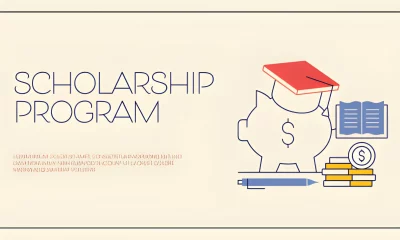Educational Terms
What is an Academy? Definition, History, Types and Examples
An Academy, in a nutshell, is a place of learning or study, typically specializing in a particular subject or subjects.
What is Academy? – Ahoy, knowledge seekers! Ever found yourself musing over the question. Well, you’re not alone. It’s a word that pops up in our day-to-day conversations, often referring to an educational institution. But is that all there is to it?
Let’s pull back the curtain and take a look at this intriguing term.
In the world of education, the word “academy” can be hard to pin down. To some, it might bring images of ancient Greece and intellectuals engaging in philosophical debates.
To others, it could mean a modern educational institution with a specific focus. Let’s dive in and find out what an academy is all about.
An Academy, in a nutshell, is a place of learning or study, typically specializing in a particular subject or subjects. The term has ancient roots, but it’s not stuck in the past. Oh no, it’s evolved and adapted, much like a chameleon changing its colors, to fit into our modern educational system.
What is an Academy?
An academy is a type of educational institution that can serve students at various levels, from secondary to tertiary education. Academies also refer to specialized programs within larger universities or dedicated research institutions.
These academies provide focused instruction and training in specific fields, offering a rigorous curriculum often aimed at preparing students for further study or professional careers. In some regions, the term academy may also denote a public or private charter school.
Key Takeaways
- The word ‘academy’ first originated in ancient Greece.
- Academy is derived from Akademos, a hero in Greek mythology.
- Plato, a famous philosopher, established his school of philosophy in a grove dedicated to this hero, and hence the name ‘Academy’ was born.
The Historical Background of Academies
Ancient Greek Academies
To understand the concept of an Academy, we need to hop onto our time machine and travel back to Ancient Greece, in Athens, around 387 BC, that the philosopher Plato established what many consider the first Academy.
This wasn’t your typical school with rigid desks and chalk dust; rather, it was a community of thinkers engaging in intellectual discourse.
Here, individuals would engage in intellectual discourse, a practice that set the foundation for modern academia.
Middle Ages and Renaissance Academies
Fast forward to the Middle Ages and the Renaissance period, academies took on a more formal educational role. They were often private or semi-private institutions focusing on subjects such as the arts, literature, and sciences. These academies played a critical role in disseminating knowledge and fostering intellectual growth during these periods.
Cue the Renaissance! This period of cultural revival saw the establishment of Academies focusing on arts and sciences. These were gatherings of intellectuals, much like their Greek predecessor, but with a more modern spin.
The New World and Academies
When settlers arrived in the New World, they brought with them the concept of the Academy. However, they gave it their own twist, transforming it into a preparatory school for higher education.
Characteristics of an Academy
Academies often have more autonomy than traditional public schools. They can set their curriculum, manage their finances, and establish their admission processes. This flexibility allows them to adapt and innovate in ways that conventional schools may not.
- Specialization: Academies focus on specialized education in specific fields such as arts, sciences, sports, or vocational training.
- Expert Instructors: Academies often attract highly qualified instructors and experts in their respective fields, ensuring high-quality instruction.
- Advanced Facilities: Academies typically have access to advanced facilities, equipment, and resources tailored to their specific field of study.
- Industry Alignment: Academies design their curriculum to align with industry standards and requirements, ensuring students gain knowledge and skills relevant to their chosen careers.
- Experiential Learning: Many academies emphasize experiential learning methods such as internships, apprenticeships, or real-world projects, allowing students to apply their knowledge in practical settings.
- Networking Opportunities: Academies provide opportunities for students to connect and collaborate with industry professionals, experts, and fellow students, fostering valuable networking connections.
- Personalized Attention: With smaller class sizes, academies can provide more individualized attention and support to students, tailoring instruction to their needs.
- Career Focus: Academies prioritize career preparation and often offer specialized training, internships, and placement programs to enhance students’ employability.
- Strong Community: Academies foster a strong sense of community among students, faculty, and alumni, providing ongoing support, mentorship, and collaboration opportunities.
- Holistic Development: Academies focus not only on academic development but also on the overall personal and professional growth of students, emphasizing character building, leadership skills, and critical thinking.
- Accreditation: Academies seek accreditation from relevant educational bodies or industry associations, ensuring quality standards and recognition.
- Competitive Advantage: Graduating from an academy can give students a competitive advantage in the job market, as employers often value specialized education and practical skills.
- Emphasis on Excellence: Academies strive for excellence in their respective fields, fostering a culture of achievement and high standards.
- Alumni Success: Academies often have a track record of successful alumni who have made notable contributions in their fields, highlighting the academy’s effectiveness in producing skilled professionals.
- Continuous Learning: Academies encourage lifelong learning and professional development, providing opportunities for alumni and professionals to update their skills and knowledge.
These characteristics contribute to the unique educational experience offered by academies, catering to students’ interests, career goals, and the demands of specialized industries.
Types of Academies
Now, onto the present day! The term “Academy” today is as varied as a box of chocolates; you never quite know what you’re going to get.
There’s a wide array of academies in today’s world, including but not limited to, military academies, police academies, arts academies, sports academies, and academies focusing on specific academic fields like science, technology, engineering, and mathematics (STEM).
Academies in the United States
In the U.S., an Academy often refers to a secondary school, both public and private. Noteworthy examples include the U.S. Military Academy and the U.S. Naval Academy, prestigious institutions focusing on military training.
Academies in the United Kingdom
Cross the pond to the U.K., and you’ll find Academies are publicly funded independent schools. They have more freedom than traditional state schools in how they conduct their affairs, but they’re held accountable by the government.
Academies Elsewhere
In other parts of the world, the term “Academy” can refer to a research institution, a sports training center, or even a government body.
Examples of Academies
- Performing Arts Academy: Focuses on disciplines such as music, dance, theater, and acting, providing specialized training and education in performing arts.
- Sports Academy: Specializes in training and developing athletes in various sports, offering coaching, fitness programs, and academic support tailored to athletes’ needs.
- STEM Academy: Concentrates on science, technology, engineering, and mathematics education, providing hands-on learning experiences and preparing students for careers in STEM fields.
- Fine Arts Academy: Focuses on visual arts, including painting, sculpture, drawing, and photography, providing instruction and opportunities for artistic expression and creativity.
- Language Academy: Specializes in language education and proficiency, offering immersive language learning programs, cultural exchange opportunities, and language certification courses.
- Culinary Academy: Concentrates on culinary arts, teaching cooking techniques, food preparation, menu planning, and hospitality management for aspiring chefs and culinary professionals.
- Business Academy: Focuses on business and entrepreneurship education, providing instruction in areas such as finance, marketing, management, and leadership skills development.
- Health and Wellness Academy: Specializes in health sciences, wellness, and healthcare-related fields, offering programs in nursing, medical assisting, nutrition, physical therapy, and other allied health professions.
- Technology Academy: Concentrates on technology-related fields, such as computer science, software development, cybersecurity, and data analytics, preparing students for careers in the tech industry.
- Environmental Academy: Focuses on environmental sciences, sustainability, and conservation, offering education and training in areas such as ecology, environmental policy, renewable energy, and environmental engineering.
- Aviation Academy: Specializes in aviation and aerospace education, providing training for pilots, aircraft maintenance technicians, air traffic controllers, and other aviation-related careers.
- Military Academy: Concentrates on military education and training, preparing students for careers in the armed forces, offering leadership development, physical fitness, and military strategy education.
- International Baccalaureate (IB) Academy: Focuses on the International Baccalaureate curriculum, providing a comprehensive and internationally recognized education that emphasizes critical thinking, global awareness, and community service.
- Virtual Academy: Offers online or blended learning programs, allowing students to access education remotely, providing flexibility and personalized learning experiences.
- Vocational Academy: Specializes in vocational training and skills development, offering programs in trades such as carpentry, plumbing, automotive, electrical work, and other hands-on professions.
These are just some examples of the different types of academies available, each catering to specific areas of interest and providing specialized education and training in various fields.
Advantages of Academies
Academies offer several benefits over traditional schools. For one, they can provide specialized education, helping students refine their skills in a specific field. Moreover, the level of autonomy they enjoy allows for a more flexible and innovative approach to education.
- Specialized Education: Academies offer specialized education in specific fields such as arts, sciences, sports, or vocational training. Students can focus on their area of interest and develop expertise in that particular field.
- High-Quality Instruction: Academies often attract highly qualified instructors and experts in their respective fields. Students benefit from their expertise and receive high-quality instruction, which can enhance their learning experience.
- Advanced Facilities and Resources: Academies typically have access to advanced facilities, equipment, and resources that are tailored to the specific field of study. This enables students to gain hands-on experience and practical skills in a well-equipped learning environment.
- Enhanced Networking Opportunities: Academies often provide opportunities for students to connect and collaborate with industry professionals, experts, and fellow students who share similar interests. This can lead to valuable networking opportunities and potential career connections.
- Career-focused Curriculum: Academies usually design their curriculum to align with industry standards and requirements. This ensures that students are equipped with the knowledge and skills that are directly applicable to their chosen career paths.
- Experiential Learning: Many academies emphasize experiential learning methods such as internships, apprenticeships, or real-world projects. This allows students to apply their knowledge in practical settings, gain valuable experience, and develop a deeper understanding of their field of study.
- Personalized Attention: With smaller class sizes, academies can provide more individualized attention to students. This allows instructors to better understand each student’s strengths, weaknesses, and learning styles, resulting in personalized support and guidance.
- Competitive Advantage: Graduating from an academy can give students a competitive advantage in the job market. Employers often value specialized education and the practical skills gained from academies, which can increase the likelihood of securing desirable employment opportunities.
- Strong Community and Alumni Network: Academies often foster a strong sense of community among students, faculty, and alumni. This supportive network can provide ongoing mentorship, collaboration opportunities, and access to a wide range of resources even after graduation.
- Holistic Development: Academies typically focus not only on academic development but also on the overall personal and professional growth of students. They often emphasize character building, leadership skills, teamwork, and critical thinking, preparing students for success in various aspects of life.
Please keep in mind that the benefits will vary depending on the academy and its programs.
Potential Drawbacks of Academies
However, there are potential drawbacks. The autonomy of academies can sometimes lead to inconsistency in the quality of education. Additionally, their admission policies might be more selective, potentially excluding some students.
- Limited Diversity: Academies that specialize in specific fields may attract a homogenous group of students, resulting in limited diversity in terms of backgrounds, perspectives, and experiences. This can hinder the exposure to different viewpoints and impede the development of well-rounded individuals.
- Narrow Focus: While specialization can be advantageous, it can also limit students’ exposure to a broader range of subjects. Academies often have a tightly focused curriculum, which may leave little room for exploration and interdisciplinary learning.
- Reduced Flexibility: Academies usually have a structured and predefined program of study, leaving less room for customization or flexibility in course selection. This can restrict students who wish to pursue a more diverse set of interests or change their academic path.
- High Costs: Academies, particularly private ones, can be expensive. Tuition fees, specialized equipment, and additional resources required for specialized training can pose a financial burden on students and their families, limiting access to certain socio-economic groups.
- Limited Extracurricular Activities: Due to the emphasis on specialized education, academies may offer limited extracurricular activities compared to traditional schools. This can limit students’ exposure to a variety of interests and opportunities for holistic development.
- Intense Competition: In academies known for their prestige or limited enrollment, the competitive nature among students can create a high-pressure environment. This intense competition may lead to stress, anxiety, and unhealthy academic practices.
- Limited Socialization Opportunities: The focused nature of academies can result in a smaller student population compared to traditional schools. This may limit socialization opportunities, diversity of friendships, and the development of social skills outside the specialized field.
- Limited Career Options: While academies can provide specialized education and training, this narrow focus may limit career options for students who later discover different interests or want to pursue alternative paths. It may be challenging to transition to a different field without additional education or training.
- Dependency on Reputation: The reputation of an academy can significantly impact students’ perception and opportunities. If an academy’s reputation declines, it may have implications for graduates’ employability or further education prospects.
- Overemphasis on Performance: Academies that prioritize performance and achievement may inadvertently place excessive pressure on students, leading to a focus on grades rather than the joy of learning. This can hinder creativity, exploration, and personal development.
It’s important to note that the drawbacks mentioned above are not universally applicable to all academies and can vary depending on the specific institution and its policies.
How to Choose the Right Academy
Choosing the right academy involves evaluating factors like the academy’s reputation, the quality of faculty, the curriculum, and the institution’s values. It’s also important to consider whether the academy’s focus aligns with your interests and future goals.
- Identify Your Interests: Determine your passions, strengths, and career goals. Look for academies that align with your areas of interest and offer programs that cater to your desired field of study.
- Research Academy Options: Conduct thorough research on different academies. Explore their websites, read reviews, and gather information about their reputation, faculty, facilities, curriculum, and alumni success stories.
- Consider Accreditation and Recognition: Check if the academy is accredited by relevant educational bodies or recognized by industry associations. Accreditation ensures that the institution meets certain quality standards and that your education will be recognized by employers or other educational institutions.
- Evaluate Curriculum and Specialization: Review the academy’s curriculum and specialization areas. Assess whether the courses and programs offered align with your educational and career goals. Look for a well-rounded curriculum that combines theoretical knowledge with practical experiences.
- Visit the Campus: If possible, schedule a visit to the academy’s campus. This will allow you to get a feel for the learning environment, facilities, and resources available. You can also interact with faculty, staff, and current students to gain insights into the academy’s culture and community.
- Consider Faculty Expertise: Look into the qualifications, experience, and expertise of the academy’s faculty members. Experienced and knowledgeable instructors can greatly enhance your learning experience and provide valuable guidance.
- Explore Internship and Placement Opportunities: Inquire about internship and placement opportunities offered by the academy. A strong network of industry connections and a track record of successful placements can be beneficial in launching your career after graduation.
- Assess Financial Considerations: Evaluate the academy’s tuition fees, financial aid options, and scholarships. Consider your financial capabilities and determine if the academy’s costs are feasible for you or if there are alternative funding options available.
- Seek Student and Alumni Feedback: Connect with current students and alumni of the academy. Seek their feedback on the quality of education, support services, career prospects, and overall experience. Their insights can provide valuable firsthand information.
- Trust Your Instincts: Ultimately, trust your instincts and choose an academy where you feel comfortable, motivated, and excited about the opportunities it offers. Consider factors such as location, campus culture, and the overall fit with your personal preferences and learning style.
Remember to carefully weigh all factors and make an informed decision that aligns with your educational and career aspirations.
Technological Influence on Academies
In the age of technology, academies are not immune to change. Online academies are becoming increasingly popular, offering a diverse range of courses to students worldwide. This opens up new avenues for learning, making education more accessible.
Academy vs. Traditional Schooling
While traditional schools play a critical role in general education, academies offer specialized training that may better suit certain students. As we move towards a more tailored approach to education, the role of academies is expected to grow.
- Specialization vs. General Education: Academies focus on specialized education in specific fields, while traditional schooling provides a more comprehensive general education across various subjects.
- Rigor and Intensity: Academies often have a more rigorous and intense academic environment due to their specialized nature, while traditional schooling typically offers a broader range of subjects with varying levels of intensity.
- Smaller Class Sizes: Academies often have smaller class sizes, allowing for more personalized attention and interaction between students and instructors. Traditional schools tend to have larger class sizes, which may limit individualized instruction.
- Career Preparation: Academies prioritize career preparation by providing specialized training and industry-specific knowledge. Traditional schools focus on a well-rounded education that prepares students for a variety of career paths.
- Access to Advanced Facilities: Academies usually have access to advanced facilities, specialized equipment, and resources tailored to their specific fields. Traditional schools may have more limited resources and facilities that cater to a broader range of subjects.
- Networking and Industry Connections: Academies often provide networking opportunities and connections with industry professionals, facilitating potential career opportunities. Traditional schools may have less direct industry exposure but can still provide networking opportunities through extracurricular activities and alumni networks.
- Flexibility and Customization: Traditional schooling typically offers more flexibility in course selection and a wider range of extracurricular activities. Academies often have a more structured curriculum with limited flexibility.
- Diversity of Learning Experiences: Traditional schooling exposes students to a wider variety of subjects, disciplines, and perspectives, promoting interdisciplinary learning and a more comprehensive understanding of the world. Academies provide in-depth knowledge and skills within a specific field of study.
- Cost: While costs can vary, academies, especially private ones, tend to be more expensive due to their specialized nature and access to advanced resources. Traditional schooling options may be more accessible and affordable for many families.
- Personal Preference: The choice between academy and traditional schooling ultimately depends on personal preference, career goals, and individual learning styles. Some students thrive in the focused environment of an academy, while others prefer the broader exposure and flexibility of traditional schooling.
It’s important to consider these factors and evaluate which educational approach aligns best with your goals, interests, and preferred learning style.
Modern Definition of Academy
In the contemporary context, an academy refers to a type of educational institution. These institutions can vary greatly from those specializing in a specific field, like a music or art academy, to those functioning like a regular school, albeit with a unique set of governing principles.
FAQs: All You Need to Know About Academies
What is an academy?
An academy is an educational institution that can vary from specializing in a specific field to functioning like a regular school with a unique set of governing principles.
Where did the term ‘academy’ originate?
The term originated in ancient Greece, with the establishment of Plato’s school of philosophy in a grove dedicated to the Greek hero “Akademos”.
What are the advantages of academies?
Academies can provide specialized education and have more autonomy than traditional schools, allowing them to adopt a flexible and innovative approach to education.
Are there any drawbacks to academies?
The autonomy of academies can sometimes lead to inconsistency in education quality. Also, their selective admission policies might exclude some students.
How has technology influenced academies?
Technology has led to the rise of online academies, making education more accessible to students worldwide.
What is an Academy in simple terms?
An Academy is a place of learning or study, often specializing in certain subjects.
How did the concept of the Academy evolve over time?
The Academy evolved from being a philosophical community in Ancient Greece to a structured educational institution in the Middle Ages, eventually transforming into various forms in modern times, including secondary schools, research institutions, and training centers.
What’s the difference between a school and an Academy?
While both are educational institutions, an Academy often specializes in certain subjects or areas. In some regions, like the U.K., Academies also have more operational freedom than traditional state schools.
Are Academies only for academic education?
Not at all! The term “Academy” is also used for institutions focusing on non-academic areas, such as sports training, arts, and military training.
Are all Academies the same around the world?
No, the definition and characteristics of an Academy can vary significantly from one region to another.
Why are Academies important?
Academies play a crucial role in fostering an environment for intellectual growth and practical skill development, hence shaping the future leaders and innovators of society.
Conclusion: The Ever-Evolving Academy
In a nutshell, “What is an Academy?” is a question with many answers, each one as unique and varied as the next. Whether it’s an intellectual hub in Ancient Greece, a medieval learning center, a Renaissance gathering of thinkers, or a modern-day secondary school, the Academy’s essence remains the same – a beacon of knowledge and learning.
The Academy’s journey, from its ancient roots to its modern interpretations, is a testament to humanity’s unquenchable thirst for knowledge. And while the form and function of an Academy may continue to evolve, its core principle of fostering learning and intellectual growth remains untouched.
So, the next time you hear the word “Academy,” remember, it’s not just a place, it’s a legacy – a legacy of knowledge, enlightenment, and the relentless human spirit to learn and grow.
Definitions by School News
The definition provided on this webpage is an authentic definition. If one intends to make a reference to this page or cite the provided definition, it is permissible to do so, but it is requested that proper attribution be given to us.
Our objective is to explain complicated educational terms in a way that is easy to understand. Each definition we publish stands out for its high accuracy and simplicity. If you have feedback about the definition or would like to suggest a new educational term, please contact us.
See what others are reading:
















